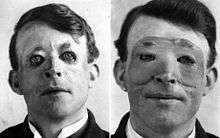Walter Yeo
Walter Ernest O'Neil Yeo (20 October 1890 – December 1960) was an English sailor in the First World War, who is thought to have been one of the first people to benefit from advanced plastic surgery, namely a skin flap.[1]

Early life
Yeo was born in Plymouth, Devon, to Petty Officer Francis Yeo and his wife Rhoda Sarah Yeo (née Jarman). He had two elder sisters, Adelaide and Elsie. Three weeks after his birth, his father was killed aboard HMS Serpent while en route to Sierra Leone, after hitting rocks off Cape Vilan, Spain. Three of the 150 people on board survived the shipwreck. His mother was later an alemaker at the Royal William Victualling Yard.
Navy
Yeo enlisted into the marine navy aged 12, serving as a bugler until 1911. He was promoted to leading seaman in 1912, becoming a petty officer in 1915 and a warrant officer in June 1917.[1]
Injuries
Yeo was wounded on 31 May 1916, during the Battle of Jutland, while manning the guns aboard the battleship HMS Warspite.[1] He sustained terrible facial injuries, including the loss of upper and lower eyelids.[1] There is some uncertainty as to where he was first admitted to hospital, due to the poor documentation. However, he is known to have been admitted to Plymouth Hospital while waiting for a place at Queen Mary's Hospital in Sidcup, Kent, which was granted on 8 August 1917. He was treated by Sir Harold Gillies, the first man to transfer skin from undamaged areas on the body.[1] Gillies' notes on this case indicate that the main disfigurement was severe ectropion as well as waxy scar tissue of the forehead and nose. Gillies opened a specialist ward at Queen Mary's Hospital for the treatment of the facially-wounded.[1] Walter Yeo is thought to have been one of the first patients to be treated with this newly developed technique; a form of skin transplantation called a 'tubed pedicle' flap.[1]
Aftermath
During the long process of surgery, a 'mask' of skin was transplanted across Yeo's face and eyes, including new eyelids. The operation to replace the skin of the midface and forehead took place in multiple stages. The first stage was the outlining of the graft as well as placement of a stent to contour for the nasal dorsum on 12 November 1917. On post-operative day five, a serious infection was noted as well as complications with the stent requiring surgical intervention. On 30 November, the second stage of the surgery was performed which consisted of excision of the scar tissue of the face and transfer of the graft. Again, post-operative infection was a major complication. Gillies described the flap as "floating in pus at one point" which required extensive care to salvage most of the tissue. In January 1918, the pedicles were returned to the chest with the surgery deemed a success. Minor revisions were performed in the following months to improve the aesthetics of the graft.[2] By July 1919, he was found to be fit for active service again and was recorded as having completed courses in September 1919. He underwent a further operation in August 1921, after which his disfigurement was recorded as 'improved, but still severe', and he was recommended for medical discharge, which took place on 15 December 1921. Walter later received further treatment for a corneal ulcer at the Royal Naval Hospital in Plymouth in 1938.
Personal and later life
Walter married Ada Edwards in 1914, and had two daughters with her: Lilian Evelyn Yeo, born 21 October 1914, and Doreen Y. Yeo, born in 1919. He died in his hometown, Plymouth, where he had spent the majority of his life, in 1960 at the age of seventy.
References
- "Walter Ernest O'Neil Yeo – One of the first people to undergo Plastic Surgery". The Yeo Society. 28 August 2008.
- Gillies, H. D., & Fry, W. K. (1920). Injuries in the region of the eyes, including burns of the face. Plastic surgery of the face: based on selected cases of war injuries of the face, including burns (). London: H. Frowde.